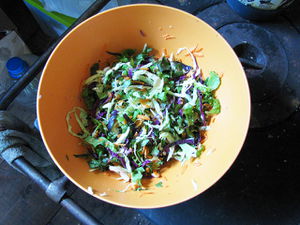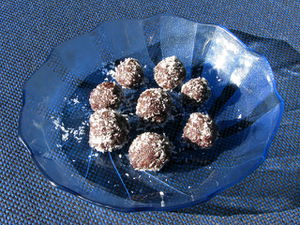Meals on the land
After a year living on the land we've developed a fairly regular selection of meals that we have most of the time. Our vege patch is still not doing well enough to fully support us so we still buy most of our food in Canela every couple of months. We have a generally quite healthy diet that's almost vegan, we still buy some cheese from the neighbours every couple of weeks and a dozen eggs every month or two, but they're not an integral part of our regular diet. I've decided to describe our recipes in detail here because a few people have expressed interest in dropping meat and moving over to a similar diet to ours after trying it for a while and feeling healthier and loosing weight.
We didn't intend to make a diet for loosing weight at all, it has a lot of frying in oil but we found that the main culprits for gaining weight are meat and processed foods such as white sugar, white flower and white rice. We use only muskavado sugar and brown rice, but we do use some white flower but only in combination with wholemeal flower. Lightly frying vegetables in oil has the effect of making them more filling and satisfying which causes one to eat less, but the heavily processed foods have the opposite effect of causing one to never feel satisfied and feel like they need to eat more even when they're full.
We recently discovered that our diet is very similar to the The Healthy Eating Pyramid which is the result of a study by the Harvard School of Public Health that rigorously analysed various diets and their results on health. This study harshly criticises the decades old food pyramid devised by the USDA (US Department of Agriculture) that has in turn been taught all over the western world and is based on a low fat, high carbohydrate diet.
Another important aspect of the diet is to try and keep the body in an alkaline not acid state. Meat and processed foods make the body very acidic, and drugs like coffee, alcohol and cigarettes even more so. This is why we decided to only have coffee and alcohol rarely on special occasions.
Contents
Bowlie
Every morning (until the fruit runs out) we have a "bowlie" for breakfast. This consists of a bowl of chopped fruit including banana, apple, papaya, mango and melon. Rolled oats and molasses are then added and mixed in. As the weeks go by after the shopping the range of fruit gets more and more sparse until the last few bowlies consist of only apple and melon and then after that it's down to "especialidade da casa" (see bottom of the page) for breakfast :-(
Salad
We have a salad with most of our meals. We eat the salad first because this prepares the digestive system for the heavier food consumed afterwards. Our salads have as a base a variety of leafy greens such as spinach, kale, lettuce and cabbage most of which come from our vege patch. We then add a grated carrot and a grated beetroot and if we have any available some chopped tomato, capsicum and/or cucumber. For seasoning we then add balsamic vinegar and gersal (ground sesame seeds with salt) and sometimes olive oil.
Fried vegetables
Usually the fried vegetables starts with frying chopped onions and/or garlic for about 5 minutes, I like to use the oil in which the sundried tomatos are preserved for frying these. Next we add a finely chopped leafy green which may be cabbage, spinach or kale and keep frying until they reduce down in size (sometimes we add sliced carrots and/or capsicum at this point too), and some canola oil may need to be added to help fry the greens. next brown rice or pasta is added and sometimes we'd add black beans at this point too (note that these have all been pre-cooked by boiling - we like to sun cook our rice if it's good weather to avoid wasting gas or wood). We add shoyu/tamari if it's rice as well as some more canola oil and sometimes a few drips of pimenta (oil in which chilli peppers have been preserving for many years) and some rock salt. We then let this fry for a good ten minutes stirring regularly. Finally we add some grated beetroot if available, some sesame oil and some parsley, marjoram or spring onion and keep frying for another 5 minutes.
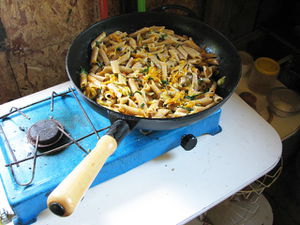
|
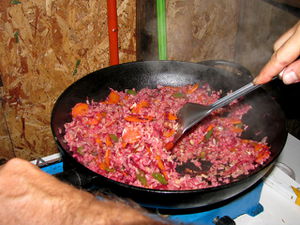
|
Flat bread & salad
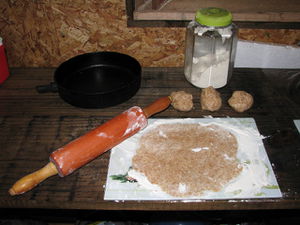
|
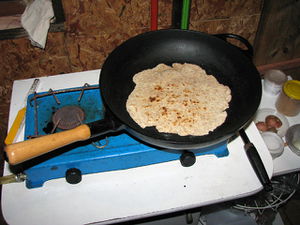
|
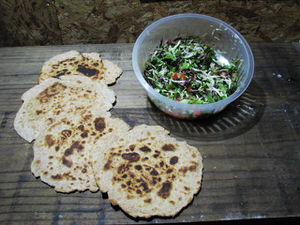
|
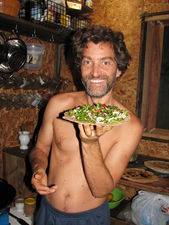
|
Pizza Mexicana
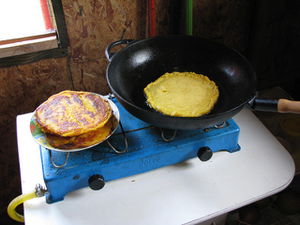
|
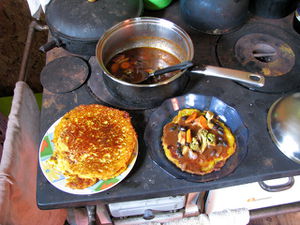
|
Biscuitos Caipera
Brigadeiro Caipera
Especialidade da casa
Especialidade da casa (specialty of the house) is a nice name to try and make us feel better about eating what is sometimes the only thing left when everything else has run out! it consists of crackers or flat bread with tahini spread on it topped with mollasses. It's quite healthy and keeps you going, but it's no longer something we look forward to after having to have nothing else for several days sometimes!

